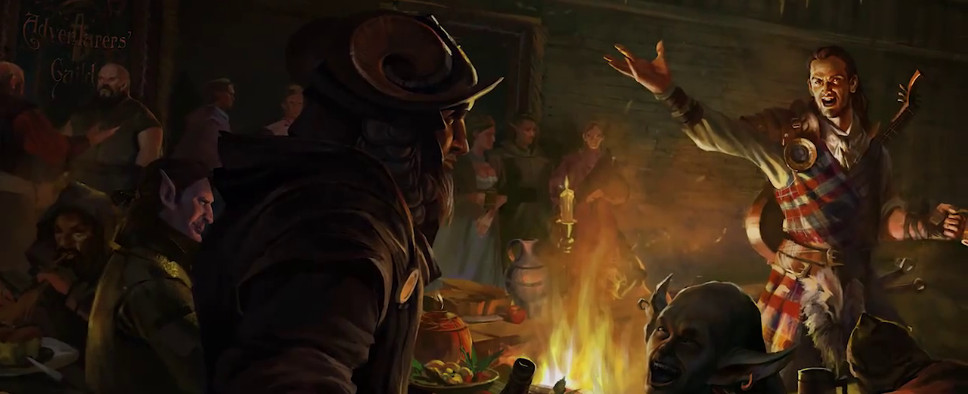The Bard's Tale IV: Barrows Deep Review - Page 2
-
Category: ReviewsHits: 13532

Article Index
And while I have nothing but good things to say about the game's sound, its visuals, on the other hand, are more uneven. You do get some nice vistas and good-looking dungeons, but most of the textures look blurry and washed out, and the game's humanoid NPCs don't look all that impressive either.
Still, if you don't play games for their fancy visuals, you'll find plenty to occupy yourself with while exploring Barrows Deep's world of Caith. The game offers a nice variety of outdoors areas and self-contained dungeons, and even though the main story path is strictly linear, most of the bigger hub areas will give you plenty of opportunities to stray from the beaten path and explore the game's robust optional content.
Oftentimes, in order to progress, you'll need to solve a puzzle or ten, and those are quite varied, to the point where you could remove all the quests and combat from the game and have it be a pretty competent puzzler.
You have your moving blocks, spinning cogs, flowing streams of energy, guidable fairies, mystical riddles, and everything in-between. And while with some of those, the developers took the quantity over quality approach, many of the puzzles are fairly inventive and satisfying even when they're not the most original.
For example, there was this one cog puzzle in a room with a moving stream of lava dripping from the ceiling. You had to solve the puzzle before you got a refreshing lava shower, which reminded me of that opening scene from Magnum, P.I. where Tom Selleck's titular character had to focus on picking a lock and not the dogs chasing him, which added a good amount of tension to the whole situation.
Apart from the puzzles, this being the bard's tale and all, you'll also have the bardic songs of exploration to help you on your journey. One of them deals with thorny vegetation blocking your way, another breaks cracked walls, and so on.
And on top of that, you have consumable items like grappling hooks, lockpicks, and acid bombs to help you get where you need to go. Not only can you find or buy those, you can also craft them, along with an assortment of potions, healing food, and even some weapons.
Another thing to mention, is that the game was designed around free movement. Usually, I prefer my dungeon crawlers to have tile-based movement, but I can't say that I was missing it in Barrows Deep. It feels nice to traverse the game's maps with the current movement setup. And the tile-based option will be added to the game later anyway as part of the Legacy Mode that will also allow you to draw your own maps, if that's your thing.
Now, unfortunately, the main quest was designed with quest markers in mind. But at the same time, some of the side quests are refreshingly cryptic and offer little clues as to what you need to do to complete them, so in that sense, Barrows Deeps strikes a decent balance between obtuse and obvious.
And overall, the game's pacing is more good than bad. Sure, the intro is pointless, the ending feels rushed, and some of the dungeons lean too heavily on either combat or puzzles, but generally you have a nice selection of activities before you, and they rarely manage to get stale before some variety comes your way.
Character System and Combat
In order to appreciate the game's combat and its underlying systems, you first have to come to terms with the fact that your character is not your character. Your party is your character.
Each individual adventurer can have up to four skills memorized, a usable trinket, and a mobility skill determined by their boots. Which leaves us with a total of six active abilities multiplied by up to six adventurers. And in order to use most of these abilities, you have to spend the so-called opportunity points that come from a shared pool. You start with three and as the game progresses, you get up to eight.
And while the game's spellcasting classes use mana for their spells instead of opportunity, for the most part in order to get mana, they still have to spend some opportunity first.
With such a setup, you shouldn't treat any individual character as your main and think of the rest as the backup crew. Instead, you should look at the encounter you're facing and consider how you can combine your party members' skills together for the best possible outcome.
If you think along these lines, having merely four spells or attacks on each individual character doesn't seem that bad. Which is why the decision to have you start the game with merely two characters and then slowly, over the course of roughly 10-15 hours, gather a full party seems counter-intuitive. Instead of learning to approach things as a well-oiled combat machine from the start, you go through the game's opening sections wondering why its skill and attribute systems feel so basic and overly simplistic.

